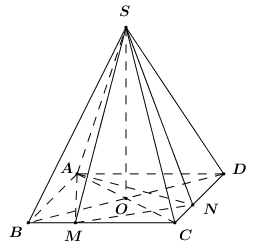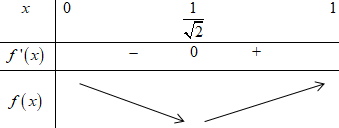Câu hỏi:
Cho khối chóp tứ giác đều \(S.ABCD\) có tất cả các cạnh bằng \(1\). Gọi \(M,\,\,N\) lần lượt thuộc các cạnh \(BC,\,\,CD\) sao cho \(MN\) luôn bằng \(1\). Tìm giá trị nhỏ nhất của thể tích khối tứ diện \(SAMN\).
- A \(\dfrac{{\sqrt 2 }}{{12}}\)
- B \(\dfrac{{\sqrt 3 }}{{12}}\)
- C \(\dfrac{{1 + \sqrt 2 }}{{12}}\)
- D \(\dfrac{{4 - \sqrt 2 }}{{24}}\)
Phương pháp giải:
Lời giải chi tiết:

Gọi \(O = AC \cap BD \Rightarrow SO \bot \left( {ABCD} \right)\).
Do \(ABCD\) là hình vuông cạnh bằng \(1\) nên \(AC = BD = \sqrt 2 \)\( \Rightarrow OA = \dfrac{1}{2}AC = \dfrac{{\sqrt 2 }}{2}\).
Áp dụng định lí Pytago trong tam giác vuông \(SOA\) ta có: \(SO = \sqrt {S{A^2} - O{A^2}} = \dfrac{{\sqrt 2 }}{2}\).
\(SO \bot \left( {ABCD} \right) \Rightarrow SO \bot \left( {AMN} \right)\).
\( \Rightarrow {V_{S.AMN}} = \dfrac{1}{3}SO.{S_{AMN}} = \dfrac{{\sqrt 2 }}{6}.{S_{AMN}}\).
Do đó \({V_{S.AMN\,\,\min }} \Leftrightarrow {S_{AMN}}\) min.
Đặt \(CM = x,\,\,CN = y\,\,\left( {0 \le x;y \le 1} \right)\), khi đó ta có \({x^2} + {y^2} = 1\) (Định lí Pytago trong tam giác vuông \(CMN\)).
Ta có
\(\begin{array}{l}{S_{ABM}} = \dfrac{1}{2}AB.AM = \dfrac{1}{2}\left( {1 - x} \right)\\{S_{ADN}} = \dfrac{1}{2}AD.DN = \dfrac{1}{2}\left( {1 - y} \right)\\{S_{CMN}} = \dfrac{1}{2}xy\\ \Rightarrow {S_{AMN}} = {S_{ABCD}} - \left( {{S_{ABM}} + {S_{ADN}} + {S_{CMN}}} \right)\\\,\,\,\,\,\,\,\,\,\,\,\,\,\,\,\,\,\, = 1 - \dfrac{1}{2}\left( {1 - x + 1 - y + xy} \right)\\\,\,\,\,\,\,\,\,\,\,\,\,\,\,\,\,\,\, = 1 - \dfrac{1}{2}\left( {2 - x - y + xy} \right)\\\,\,\,\,\,\,\,\,\,\,\,\,\,\,\,\,\,\, = \dfrac{1}{2}\left( {x + y - xy} \right)\end{array}\)
Ta có \({x^2} + {y^2} = 1 \Leftrightarrow y = \sqrt {1 - {x^2}} \). Khi đó ta có \(S = \dfrac{1}{2}\left( {x + \sqrt {1 - {x^2}} - x\sqrt {1 - {x^2}} } \right)\).
Xét hàm số \(f\left( x \right) = x + \sqrt {1 - {x^2}} - x\sqrt {1 - {x^2}} \) với \(x \in \left( {0;1} \right)\) ta có:
\(\begin{array}{l}y' = 1 - \dfrac{x}{{\sqrt {1 - {x^2}} }} - \sqrt {1 - {x^2}} - x.\dfrac{{ - x}}{{\sqrt {1 - {x^2}} }}\\y' = \dfrac{{\sqrt {1 - {x^2}} - x - \left( {1 - {x^2}} \right) + {x^2}}}{{\sqrt {1 - {x^2}} }}\\y' = \dfrac{{\sqrt {1 - {x^2}} + 2{x^2} - x - 1}}{{\sqrt {1 - {x^2}} }}\end{array}\)
\(\begin{array}{l}y' = 0 \Leftrightarrow \sqrt {1 - {x^2}} + 2{x^2} - x - 1 = 0\\\,\,\,\,\,\,\,\,\,\,\,\,\, \Leftrightarrow \sqrt {\left( {1 - x} \right)\left( {1 + x} \right)} + \left( {x - 1} \right)\left( {2x + 1} \right) = 0\\\,\,\,\,\,\,\,\,\,\,\,\, \Leftrightarrow \sqrt {1 - x} \left[ {\sqrt {1 + x} - \sqrt {1 - x} \left( {2x + 1} \right)} \right] = 0\\\,\,\,\,\,\,\,\,\,\,\,\, \Leftrightarrow \left[ \begin{array}{l}x = 1\\\sqrt {1 + x} - \sqrt {1 - x} \left( {2x + 1} \right) = 0\end{array} \right.\\\,\,\,\,\,\,\,\,\,\,\,\, \Leftrightarrow \left[ \begin{array}{l}x = 1\\1 + x = \left( {1 - x} \right){\left( {2x + 1} \right)^2}\end{array} \right.\\\,\,\,\,\,\,\,\,\,\,\,\, \Leftrightarrow \left[ \begin{array}{l}x = 1\\4{x^3} - 2x = 0\end{array} \right.\\\,\,\,\,\,\,\,\,\,\,\,\, \Leftrightarrow \left[ \begin{array}{l}x = 1\\x = 0\\x = \dfrac{1}{{\sqrt 2 }}\end{array} \right.\end{array}\)
BBT:

Dựa vào BBT ta thấy \(\mathop {\min }\limits_{\left[ {0;1} \right]} f\left( x \right) = f\left( {\dfrac{{\sqrt 2 }}{2}} \right) = \dfrac{{2\sqrt 2 - 1}}{4}\).
\( \Rightarrow \min {S_{AMN}} = \dfrac{{2\sqrt 2 - 1}}{4}\).
Vậy \(\min {V_{S.AMN}} = \dfrac{{\sqrt 2 }}{6}.\dfrac{{2\sqrt 2 - 1}}{4} = \dfrac{{4 - \sqrt 2 }}{{24}}\)
Chọn D.


















